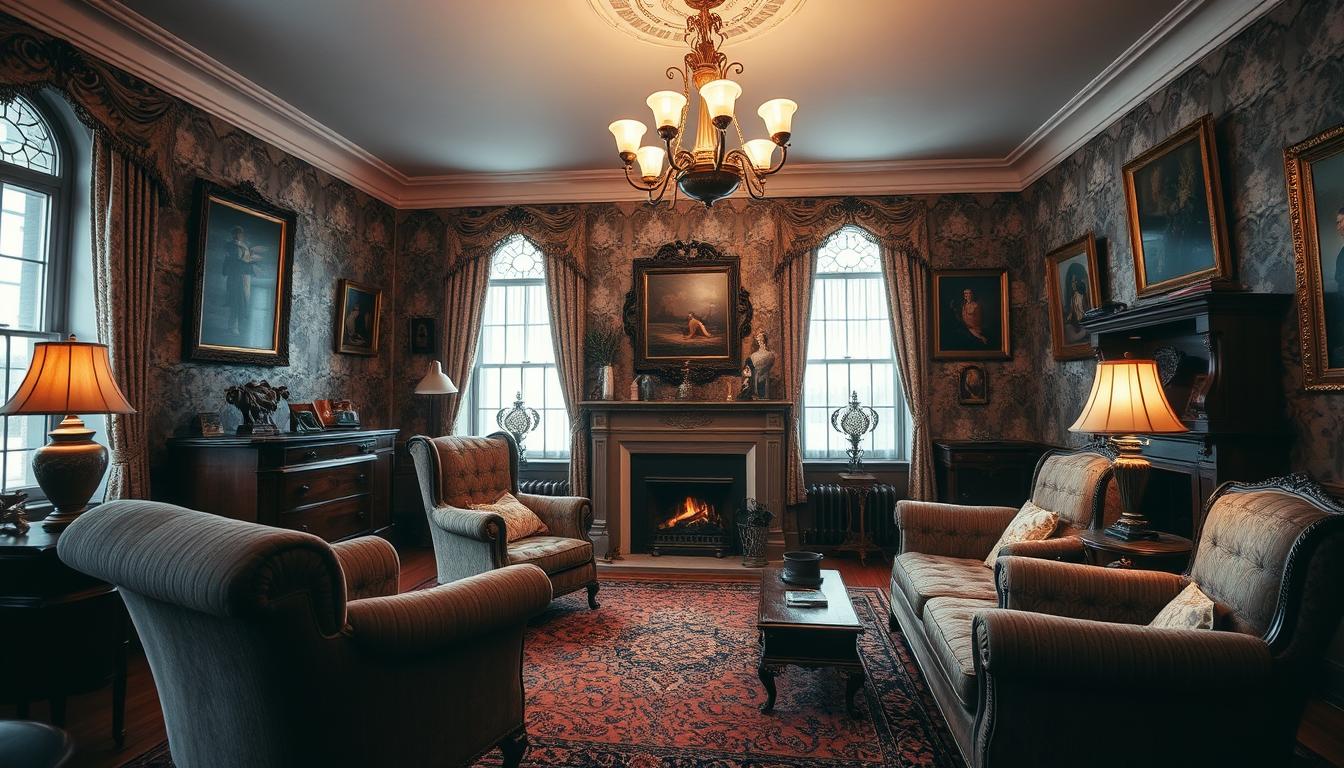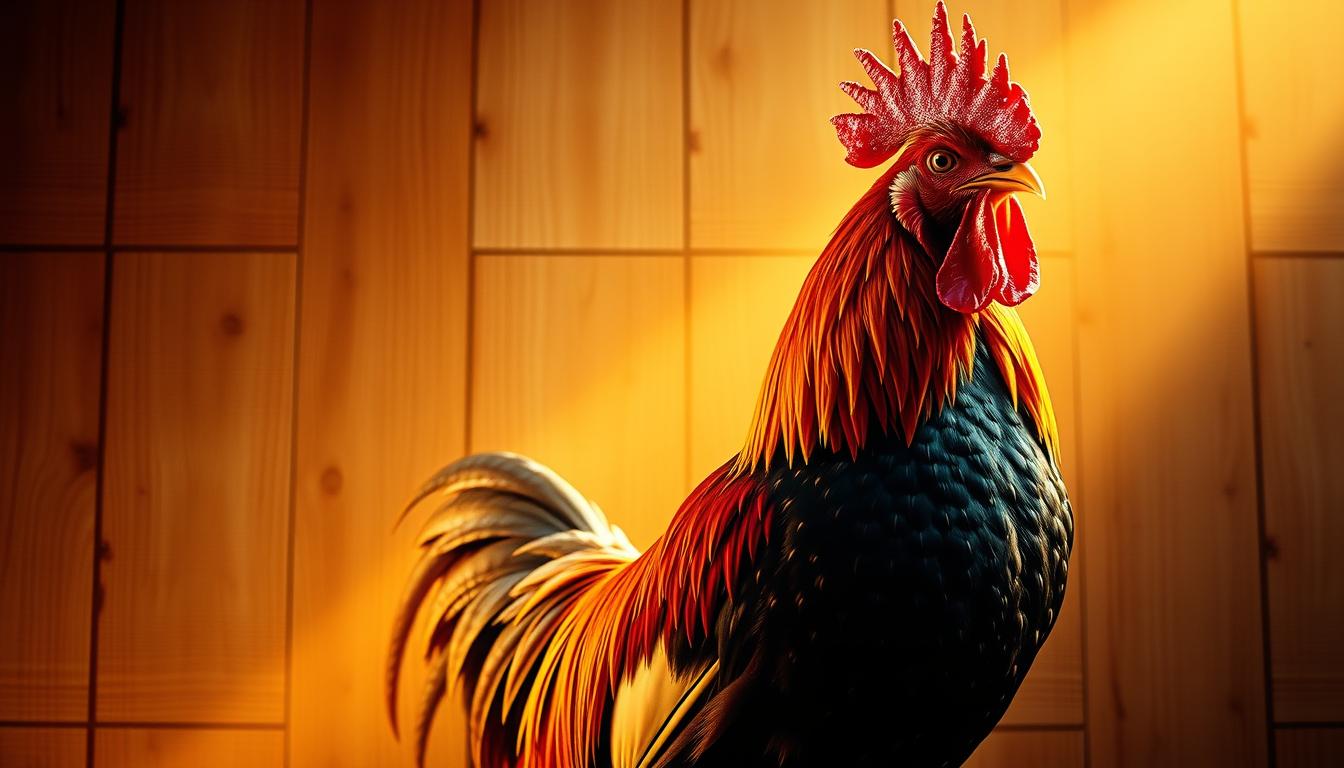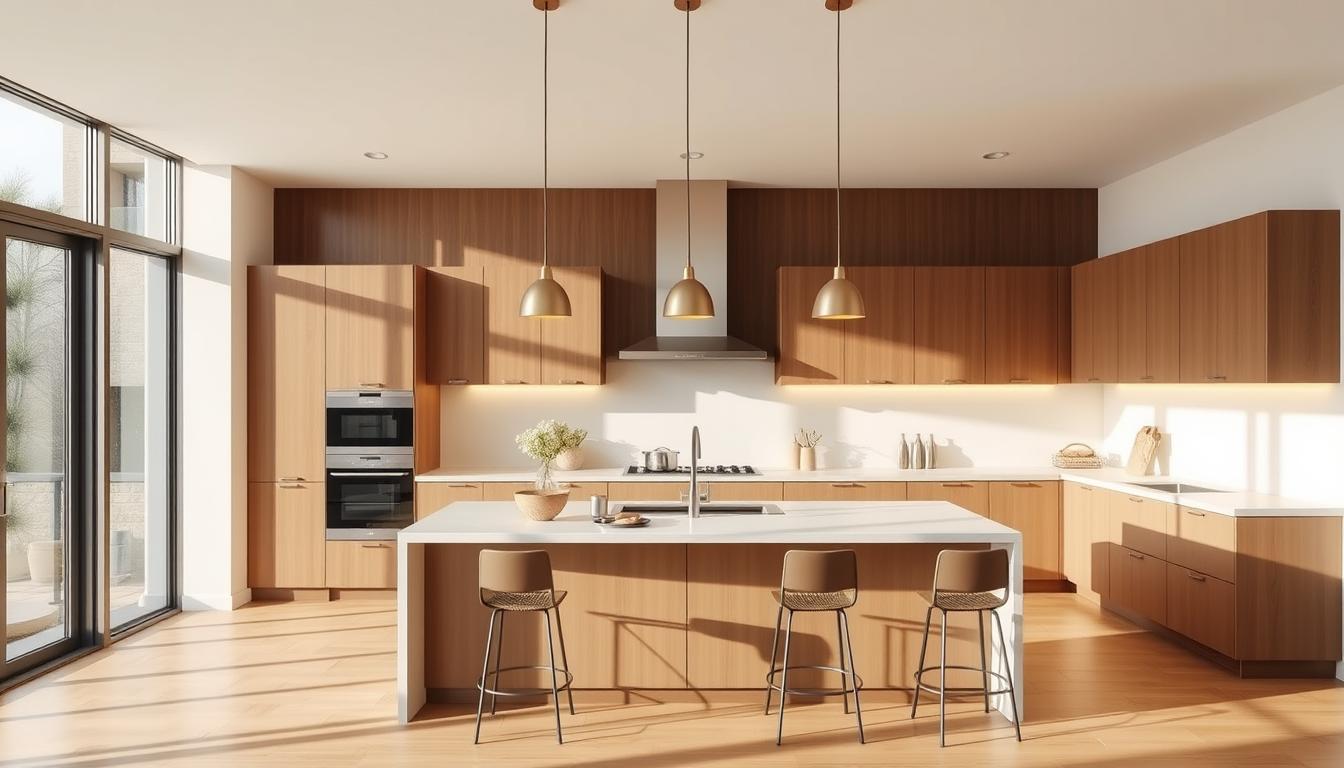The Roaring Twenties were a time of big change in culture and society. They also saw a big shift in vintage home decor. The era’s design, known as Art Deco, is still loved today. We’ll show you how to add the glamour of the 1920s to your home.
We’ll cover the main parts of 1920s style. You’ll learn about key furniture and decorative items. We’ll give you tips to make your home look sophisticated and vintage.
Key Takeaways
- Understanding the influence of Art Deco on 1920s design.
- Identifying iconic furniture pieces of the era.
- Learning how to incorporate retro elements into modern spaces.
- Discovering tips for creating a vintage-inspired aesthetic.
- Exploring ways to balance vintage and modern decor.
Understanding the 1920s Design Aesthetic
The 1920s saw a big change in interior design with the rise of Art Deco. This style was all about luxury and class. It mixed modern and traditional elements, making a unique look that still inspires today.
Key Characteristics of 1920s Interior Design
The 1920s were known for their opulence. Rich materials and bold colors were key. Geometric patterns, metallic materials, and luxurious fabrics made homes glamorous.
Some important features include:
- Luxurious materials like marble, ivory, and ebony
- Bold, geometric patterns and motifs
- Metallic accents, like chrome and silver
- Ornate furnishings and decorative pieces
Elsie de Wolfe, a famous designer, said, “The modern decorator is a master of atmosphere, not of mere furnishing.” This shows the 1920s focus on luxury and class.
The Influence of Art Deco on Home Interiors
Art Deco was key in 1920s home design. It used geometric shapes, metallic materials, and bold colors. This style brought luxury and modernity to homes.
Art Deco was more than looks; it made a statement. Its interiors were bold and bright, showing off luxury and glamour.
“Art Deco is not just a style, it’s a way of life.” –
To add Art Deco to your home, use decorative items like vases and furniture with geometric patterns. This brings 1920s glamour to your modern space.
Color Palettes of the 1920s
The 1920s were all about bold colors and luxurious materials. This era’s interior design showed off opulence and modernity. The colors of this time mixed deep, rich tones with softer pastels. This mix created a unique look that still inspires today.
Popular Colors and Their Significance
In the 1920s, certain colors became very popular. Deep jewel tones like emeralds, sapphires, and rubies added luxury and sophistication. These colors were often paired with metallics like gold and silver for an even more opulent feel.
Soft pastels also played a big role in 1920s design. Hues like pale pink, baby blue, and mint green brought a softer, more romantic feel. These colors were often used in bedrooms and nurseries for a calming effect.
“The use of color in the 1920s was not just about aesthetics; it was also about creating a certain atmosphere or mood within a space.” – Interior Design Expert
How to Incorporate Bold Colors
Adding bold colors to your decor can be fun and creative. Here are some tips to get you started:
- Start with a statement piece, such as a bold-colored sofa or armchair, and build your color scheme around it.
- Use bold colors on accent walls to create a focal point in a room.
- Incorporate vintage or vintage-inspired accessories, such as vases, rugs, and throw pillows, in bold colors to add depth and character to your space.
For a more subtle look, use bold colors in smaller doses. Try them through artwork or decorative accessories. This adds a touch of 1920s flair without overwhelming the space.
| Color | Significance | Usage in 1920s Interiors |
|---|---|---|
| Emerald Green | Luxury, Sophistication | Accent walls, Furniture upholstery |
| Sapphire Blue | Elegance, Refined Taste | Decorative accessories, Wall art |
| Pale Pink | Romance, Softness | Bedrooms, Nurseries |
Understanding the significance of colors and how to use them can create a space that honors the 1920s. It also reflects your personal style.
Furniture Styles in the 1920s
Furniture in the 1920s was both functional and ornately decorative. The era saw a rise in antique furnishings prized for their beauty and craftsmanship.
The 1920s were a mix of luxury and modernity in furniture styles. Art Deco, which emerged then, brought geometric shapes, metallics, and bold colors into design.
Iconic Furniture Pieces You Should Know
Some iconic 1920s furniture pieces include:
- Velvet sofas with intricate patterns and bold colors
- Exotic hardwood furniture, like ebony and mahogany, often with inlaid designs
- Chrome and glass tables for a modern touch
- Ornate armchairs with carved wooden frames and plush upholstery
These pieces showed the era’s opulence and the craftsmanship of 1920s furniture making.
Materials and Fabrics Used During the Era
The 1920s favored luxurious materials and fabrics in furniture making. Popular materials included:
| Material/Fabric | Description | Common Use |
|---|---|---|
| Velvet | A soft, luxurious fabric with a smooth surface | Upholstery for sofas and armchairs |
| Ebony | A dense, black hardwood | Furniture frames and decorative accents |
| Chrome | A shiny, metallic material | Table frames and other decorative elements |
Using these retro design ideas can give your home a 1920s look. Whether you’re restoring a piece or choosing modern furniture inspired by the era, knowing the materials and styles of the 1920s is crucial for a cohesive and stylish space.
Art and Decor Trends of the 1920s
Art Deco changed 1920s interior design, bringing a glamorous and modern look. This era’s trends mixed luxury, modernity, and geometric patterns. These changes showed the cultural and societal shifts of the time.
Famous Artists and Their Influence
The 1920s were marked by the rise of influential artists. Tamara de Lempicka and Jean Dupas were among them. Their work, full of elegance, luxury, and modernity, shaped the era’s art and decor.
Their art, with its bold colors, geometric shapes, and luxury, influenced the era’s decor. This included furniture and wall art. These elements became key to 1920s design, showing the era’s artistic innovation.
Tips for Selecting Wall Art
When picking wall art for a 1920s look, look for Art Deco style pieces. Choose art with geometric patterns, metallic accents, and luxury. Reproductions of famous works, like Tamara de Lempicka’s, can enhance your decor.
Match your wall art with your color palette and furniture. A bold, geometric print can make a room pop with neutral walls. Also, think about the frame style. Metallic or ornate frames can add to the Art Deco look.
By choosing wall art that reflects the 1920s, you can create a classic, elegant space. This design is both stylish and timeless.
Flooring Options for 1920s Interiors
In the 1920s, flooring was key in home design. People chose materials that showed elegance and style.
Influential Flooring Materials
The 1920s had many flooring options, each with its own charm. Hardwood flooring was a top pick, with oak being a favorite. It was durable and had a timeless look.
Terrazzo and marble were used in entryways and bathrooms for luxury. Linoleum and carpet were picked for their practicality and comfort in different rooms.
Modern Alternatives Inspired by the 1920s
Today, you can bring 1920s style into your home with modern flooring. Engineered hardwood is a modern take on traditional hardwood. It’s stable and eco-friendly.
For a real 1920s feel, try porcelain tiles that look like terrazzo or marble. These tiles are not only beautiful but also durable and easy to care for.
| Flooring Material | 1920s Characteristics | Modern Alternatives |
|---|---|---|
| Hardwood | Solid oak, durability, classic look | Engineered hardwood, wider planks, eco-friendly |
| Terrazzo/Marble | Luxurious appearance, used in entryways and bathrooms | Porcelain tiles mimicking terrazzo/marble, durable, easy maintenance |
| Linoleum/Carpet | Practicality, comfort, various patterns and colors | Modern linoleum with new designs, synthetic carpets with improved durability |
Lighting in 1920s Homes
Lighting in 1920s homes was more than just a need; it was an art form. It added to the ambiance and sophistication of living spaces. The era saw the rise of opulent lighting fixtures that became a hallmark of the Gatsby inspired decor. These fixtures reflected the luxury and modernity of the Roaring Twenties.
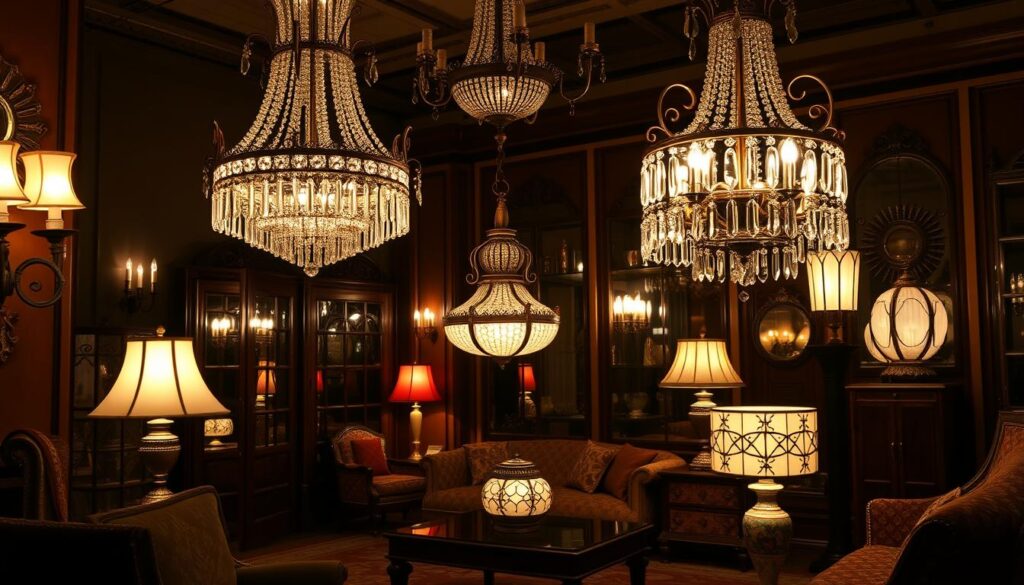
The types of lighting fixtures used during the 1920s were diverse. They ranged from grand chandeliers to elegant sconces. These fixtures were often made with luxurious materials like crystal, bronze, and marble. They added a touch of sophistication to any room.
Types of Lighting Fixtures Used
Chandeliers were a popular choice for lighting in 1920s homes. They were often used in dining rooms and entryways. They came in various styles, from elaborate crystal designs to more geometric forms inspired by Art Deco. Sconces were another favored option, used to create pools of warm light in hallways and living areas.
- Crystal chandeliers that refracted light and added a touch of glamour
- Geometric sconces that provided both light and a decorative element
- Table lamps with intricate designs and luxurious materials
As
“The 1920s was an era of great change and creativity in interior design, with lighting playing a pivotal role in setting the tone for homes.”
The use of these fixtures not only illuminated spaces. They also served as decorative pieces that reflected the homeowner’s style.
Creating Mood with 1920s Lighting
To recreate the ambiance of 1920s homes, consider how lighting can create mood. Soft, warm lighting can evoke a sense of intimacy and coziness. Brighter, more dramatic lighting can create a lively, party atmosphere reminiscent of the era’s vibrant social scene.
By incorporating a mix of lighting sources, homeowners can achieve a layered lighting effect. This adds depth and visual interest to a room. This approach is in line with retro design ideas that emphasize creativity and eclecticism.
In conclusion, lighting in 1920s homes was a critical element. It contributed to the era’s distinctive aesthetic. By understanding the types of lighting fixtures used and how they were employed to create mood, homeowners today can draw inspiration from the past. They can create their own unique spaces.
Key Accessories for Authentic 1920s Interiors
The details are what make 1920s interior design special. Accessories were key in finishing off 1920s home interiors. They included decorative objects and textiles, adding authenticity to any room.
Decorative Objects That Reflect the Era
Decorative objects in the 1920s were all about luxury and glamour. Some standout items include:
- Antique vases: Often had geometric patterns and metallic touches.
- Vintage figurines: Made from porcelain or bronze, they brought elegance.
- Art Deco sculptures: Featured bold shapes and were made from marble or metal.
Textiles and Their Importance
Textiles were crucial in 1920s interior design. Luxurious fabrics like silk, velvet, and linen were used a lot. They were used for furniture, curtains, and more.
Some key textiles of the era include:
- Velvet: Used for furniture and drapes, velvet added luxury.
- Geometric patterned fabrics: Used for upholstery and wallpaper, they showed off Art Deco style.
- Embroidered linens: Used for tablecloths, napkins, and more, they were detailed and decorative.
By adding these decorative objects and textiles, you can make a 1920s interior that’s full of glamour and sophistication.
The Role of Architecture in 1920s Homes
The 1920s brought big changes to home design, deeply affecting interior styles. Homes of this era were more than just pretty. They showed off the big changes and new tech of the time.
Typical Architectural Styles
In the 1920s, homes came in many styles, from old to new. Art Deco was big, known for its cool shapes and fancy materials. It changed how homes looked inside and out.
The Craftsman style was also popular. It focused on handmade touches and simple roofs. These homes had open layouts, making them feel big and welcoming.
Design Features to Highlight
1920s homes had some standout features. Large windows were key, bringing in lots of light. Ornate moldings and staircases added beauty to the inside.
“The house is a machine for living in.” – Le Corbusier
Le Corbusier’s words capture the 1920s’ architectural spirit. It was about making homes both useful and beautiful. Keeping these features in 1920s homes keeps their classic look alive, even for today’s needs.
Landscape and Outdoor Design
The 1920s were not just about fancy interiors. They also celebrated outdoor beauty, from gardens to stylish decor. We see that design rules for indoors were also applied outdoors, making spaces feel connected.
Inspiration for Gardens and Outdoor Spaces
Gardens and outdoor areas in the 1920s were like home extensions. They showed the same care and style as indoor spaces. Formal gardens, with their neat layouts and fancy fountains, were big hits, showing the era’s love for grandness.
To get a 1920s garden vibe, think about adding:
- Symmetrical plants
- Ornate fountains
- Classical statues
- Gatsby-inspired decor, like art deco and metallic touches
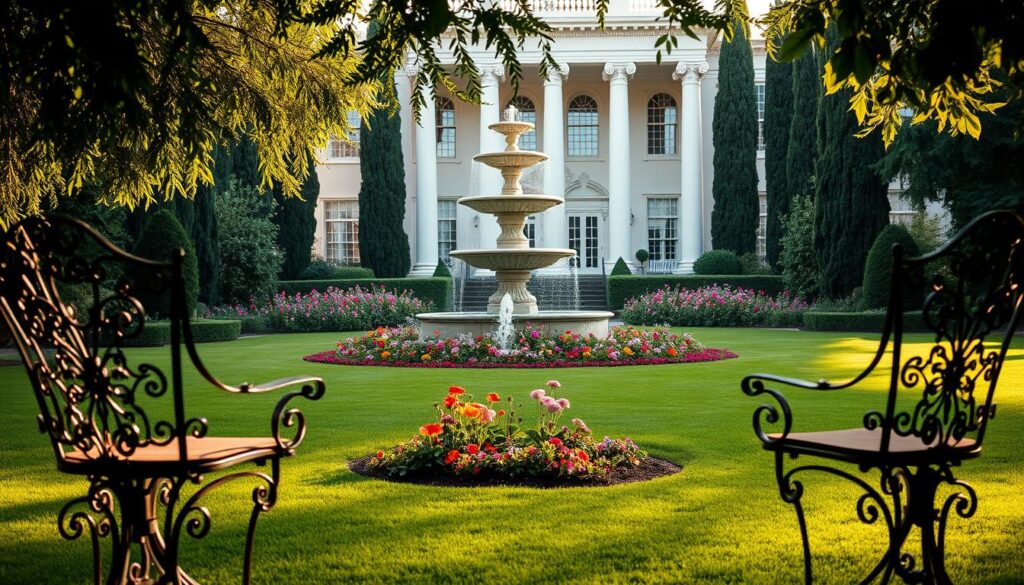
Incorporating Hardscape into Your Design
Hardscape, like patios and walls, was key in 1920s outdoor design. It gave gardens shape and structure. Bricks, stones, and concrete were used, often in detailed patterns.
When adding hardscape to your design, remember:
| Material | Characteristics | Design Tips |
|---|---|---|
| Brick | Classic, durable, versatile | Try patterns like herringbone or basketweave for interest |
| Stone | Elegant, natural, varied textures | Pick stones that match your home’s look; use in dry stacks or joints |
| Concrete | Modern, flexible, durable | Stamp or stain it to look like other materials; great for big areas |
By mixing these elements, you can make an outdoor space that respects 1920s design but also fits your modern tastes.
Integrating Modern Amenities into 1920s Style
To make a unique living space, mix the charm of the 1920s with today’s needs. This means adding modern comforts to a vintage look.
When combining old and new, keep the original design’s spirit. Add modern touches that make life easier. For example, keeping original hardwood floors and adding underfloor heating is a good mix.
Balancing Old and New Design Elements
Creating a mix of 1920s style and modern comforts needs careful thought. It’s about both looks and function. Here are some tips:
- Choose modern appliances that look like they’re from the 1920s to match the decor.
- Add smart home tech in a way that doesn’t ruin the vintage feel.
- Use new lighting that reminds you of the 1920s’ geometric patterns.
As
“The art of interior design lies in the ability to balance contrasting elements to create a cohesive whole.”
This idea is key when mixing modern comforts with 1920s homes.
Examples of Successful Blends
There are many ways to mix 1920s style with today’s needs. For instance, putting modern kitchen appliances behind vintage cabinets keeps the look while adding today’s ease.
| Design Element | 1920s Style | Modern Amenity |
|---|---|---|
| Lighting | Ornate chandeliers | Energy-efficient LED bulbs |
| Kitchen | Vintage cabinetry | Modern appliances |
| Flooring | Hardwood floors | Underfloor heating |
By carefully combining these, homeowners get the elegance of the 1920s and today’s ease.
Renovation Tips for 1920s Homes
Renovating a 1920s home is a delicate dance. You need to keep its vintage charm while adding modern touches. It’s a challenge to update the home without losing its historical feel.
Preserving Original Features
Keeping the home’s original features is key. This means saving wooden flooring, stained glass windows, and intricate moldings. These elements add beauty and historical value.
To keep these features in top shape, homeowners should:
- Learn about the home’s history to understand its design and materials.
- Seek out experts in historical home renovations.
- Use traditional methods to fix or restore original parts.
When to Update Without Losing Charm
Sometimes, updates are needed to make the home work for today’s life. This might include new electrical systems, plumbing, or insulation. The trick is to update without losing the home’s original charm.
For example, in the kitchen, you can add modern appliances. But keep the look of the 1920s with vintage-style cabinets and fixtures. Modern lighting can also be added to enhance the home’s original lighting.
| Original Feature | Modern Update | Benefit |
|---|---|---|
| Wooden Flooring | Refinished or Replaced with Matching Wood | Preserves Aesthetic, Enhances Durability |
| Stained Glass Windows | Restored or Replicated | Maintains Historical Integrity, Adds Character |
| Outdated Electrical Systems | Modern Electrical Upgrades | Improves Safety, Increases Efficiency |
By finding the right balance, homeowners can enjoy a 1920s home’s charm and modern comforts. It’s all about preserving the past while embracing the present.
Final Thoughts on 1920s Home Interiors
Designing 1920s home interiors is about embracing the spirit of the era while making it your own. By incorporating key elements such as 1920s color schemes and art deco style, you can create a unique and authentic space.
The Essence of the Era
To capture the essence of 1920s interior design, focus on bold geometric patterns, metallic accents, and statement lighting fixtures. These elements will help you create a space that exudes luxury and sophistication.
Resources for Inspiration
For further inspiration and guidance, explore design resources such as vintage magazines, interior design books, and online platforms featuring art deco style and 1920s color schemes. We recommend visiting museums and historical homes to experience the era’s architecture and design firsthand.
By balancing old and new design elements, you can create a harmonious blend of 1920s charm and modern functionality. With these tips and resources, you’ll be well on your way to designing a 1920s-inspired home that reflects your personal style.

